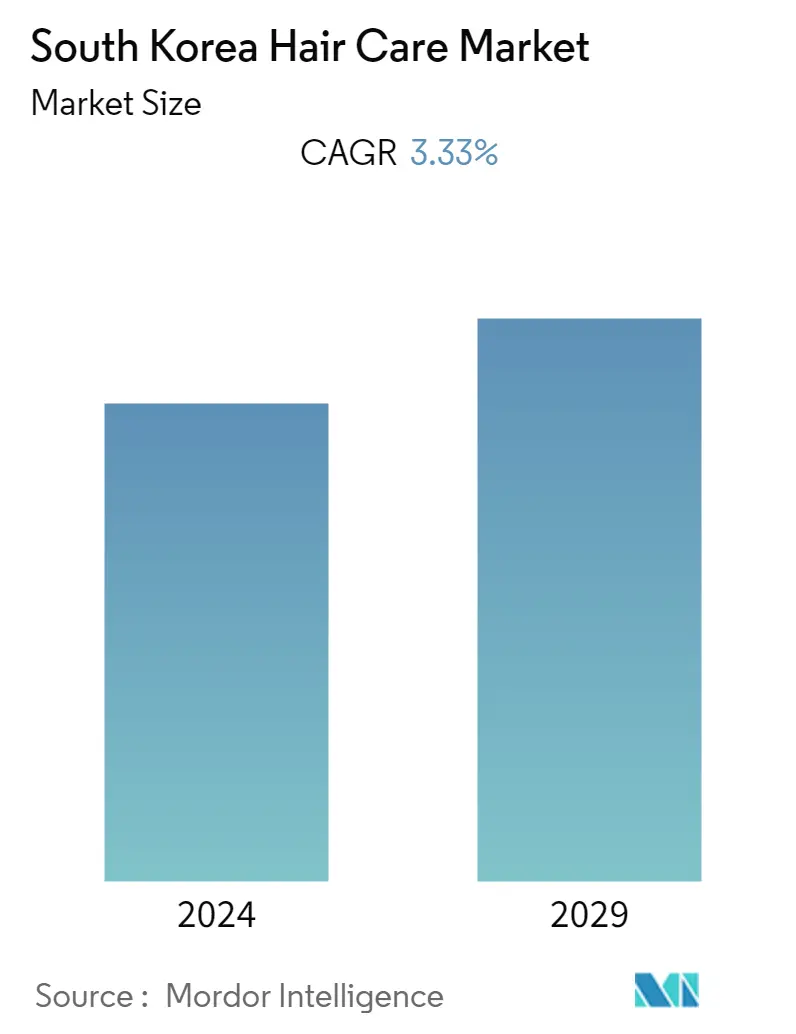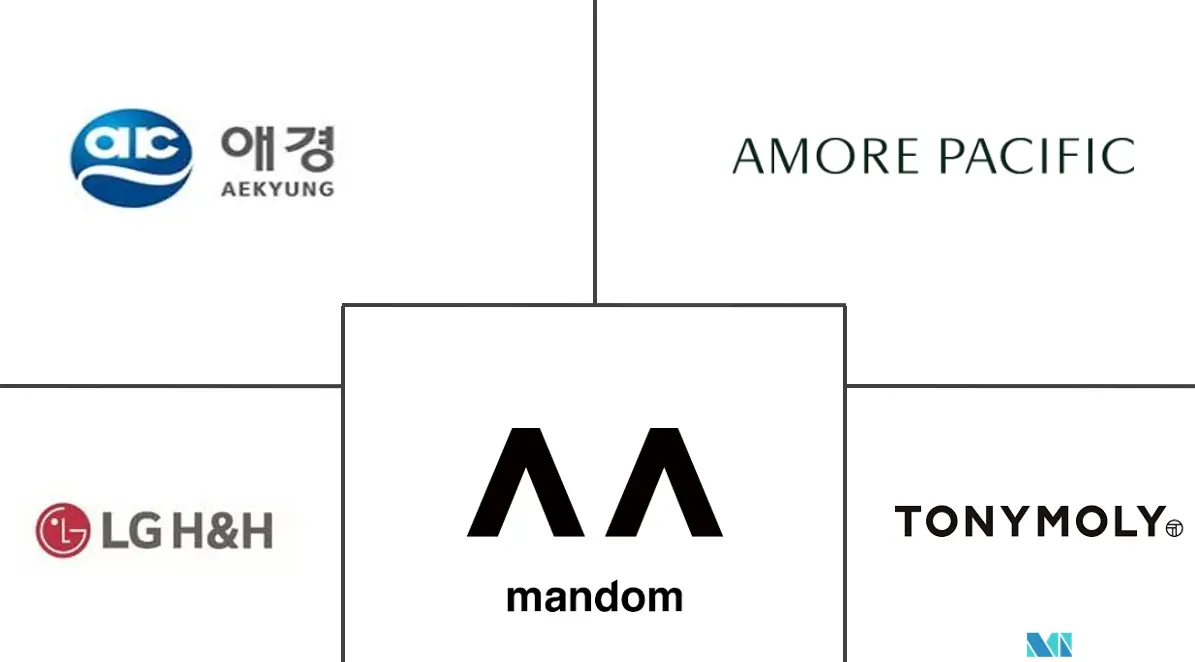Market Size of South Korea Hair Care Industry

| Study Period | 2019 - 2029 |
| Base Year For Estimation | 2023 |
| Forecast Data Period | 2024 - 2029 |
| Historical Data Period | 2019 - 2022 |
| CAGR | 3.33 % |
| Market Concentration | High |
Major Players
*Disclaimer: Major Players sorted in no particular order |
South Korea Hair Care Market Analysis
South Korea Hair Care market is projected to witness a CAGR of 3.33% during the upcoming five years.
Salon professional hair care in South Korea is becoming more consumer-friendly, by expanding its retail coverage and frequently introducing new products. Consumers believe salon professional hair care can satisfy more detailed concerns regarding the condition of their hair. Efforts to seek better options for maintaining healthy hair have led to more purchases among Koreans of either salon hair care or standard shampoos with extra functions. South Korean consumers' desire to maintain healthy and smooth hair is also leading conditioners and treatments to see positive growth. Customers in South Korea are looking for haircare products that are novel and can give them a sense of luxury and a soothing experience. On the other hand, an increasing number of South Korean women are searching for creative haircare solutions, color combinations, and new textures. This factor has been driving the hair care market in the region.
In addition, the changing consumer dynamics, coupled with increasing product awareness, have been identified as the major drivers of the market. Increasing millennial consumers, migration toward cities, and rising women's employment are further augmenting the market demand. Additionally, migration to cities has directly impacted the market for traditional hair care products. Furthermore, the existing population of cities is driving sales from specialty stores, e-commerce websites, and salons in particular.
South Korea Hair Care Industry Segmentation
Hair care products are applied to provide natural solutions for common hair troubles, such as itchy scalp, hair loss, dandruff, frizzy hair, split ends, etc. They are also used to provide hair styling hair cleansing and conditioning. South Korean haircare market is segmented by product types, such as shampoo, conditioner, Hair Gel, Hair Colorant, and others product types. By distribution channel, the market is segmented into specialist retail stores, supermarkets/hypermarkets, convenience stores, online retail channels, Specialty retail stores, and Other distribution channels. For each segment, the market sizing and forecasts have been done on the basis of value (in USD million).
| By Product Type | |
| Shampoo | |
| Conditioner | |
| Hair Gel | |
| Hair Colorant | |
| Other Product Types |
| By Distribution Channel | |
| Supermarkets/Hypermarkets | |
| Convenience Stores | |
| Specialty Retail Stores | |
| Online Retail Channels | |
| Other Distribution Channels |
South Korea Hair Care Market Size Summary
The South Korean hair care market is experiencing a notable transformation, driven by evolving consumer preferences and increasing awareness of product offerings. Consumers in South Korea are increasingly drawn to salon professional hair care products, which are perceived to address more specific hair concerns and offer a sense of luxury and indulgence. This trend is further fueled by a growing interest in innovative hair care solutions, such as creative color combinations and new textures. The market is also witnessing a rise in demand for conditioners and treatments, as consumers prioritize maintaining healthy and smooth hair. The urban migration, rising millennial population, and increased women's employment are contributing to the market's expansion, with specialty stores, e-commerce platforms, and salons playing a pivotal role in driving sales.
The online retail channel is experiencing significant growth, with consumers preferring the convenience of shopping for hair care products from home, a trend that gained momentum during the COVID-19 pandemic. This shift has prompted brands to focus on e-commerce strategies to enhance their market presence and consumer base. Leading companies like LG Household & Health Care Ltd and AmorePacific Corp are actively engaging in aggressive promotions and product innovations to maintain their competitive edge. Additionally, the market is witnessing the emergence of indie brands that cater to specific consumer needs, further diversifying the product landscape. The demand for nourishing hair care products is also on the rise, driven by concerns over pollution, UV exposure, and the use of harsh chemical products.
South Korea Hair Care Market Size - Table of Contents
-
1. MARKET DYNAMICS
-
1.1 Market Drivers
-
1.2 Market Restraints
-
1.3 Porter's Five Forces Analysis
-
1.3.1 Threat of New Entrants
-
1.3.2 Bargaining Power of Buyers/Consumers
-
1.3.3 Bargaining Power of Suppliers
-
1.3.4 Threat of Substitute Products
-
1.3.5 Intensity of Competitive Rivalry
-
-
-
2. MARKET SEGMENTATION
-
2.1 By Product Type
-
2.1.1 Shampoo
-
2.1.2 Conditioner
-
2.1.3 Hair Gel
-
2.1.4 Hair Colorant
-
2.1.5 Other Product Types
-
-
2.2 By Distribution Channel
-
2.2.1 Supermarkets/Hypermarkets
-
2.2.2 Convenience Stores
-
2.2.3 Specialty Retail Stores
-
2.2.4 Online Retail Channels
-
2.2.5 Other Distribution Channels
-
-
South Korea Hair Care Market Size FAQs
What is the current South Korea Hair Care Market size?
The South Korea Hair Care Market is projected to register a CAGR of 3.33% during the forecast period (2024-2029)
Who are the key players in South Korea Hair Care Market?
Amorepacific Corporation, LG Household & Health Care Ltd, Tony Moly, AEKYUNG Industry Co., Ltd. and Mandom Corporation are the major companies operating in the South Korea Hair Care Market.

